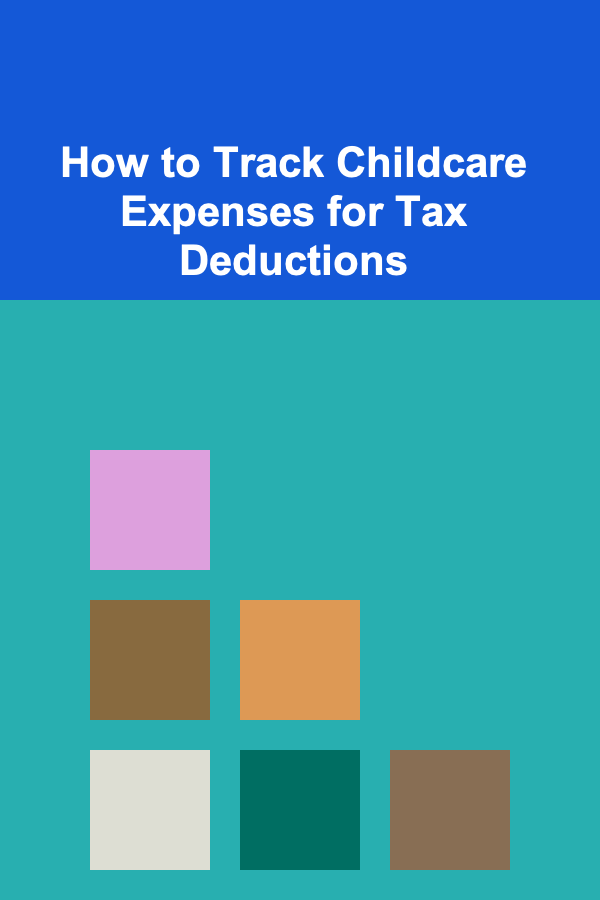
How to Track Childcare Expenses for Tax Deductions
ebook include PDF & Audio bundle (Micro Guide)
$12.99$7.99
Limited Time Offer! Order within the next:

When it comes to taxes, every eligible deduction can make a difference. One such deduction available to many parents is related to childcare expenses. The Child and Dependent Care Credit is a tax break that can help offset the cost of childcare, and understanding how to track these expenses correctly is crucial for maximizing your potential tax savings.
In this article, we'll dive into the details of how to track childcare expenses for tax deductions, what qualifies as a deductible expense, and how you can optimize your record-keeping to ensure you're maximizing your credit.
Understanding the Child and Dependent Care Credit
The Child and Dependent Care Credit is a tax benefit available to parents who incur costs for the care of their children or dependents while they work or look for work. This credit is designed to ease the financial burden of childcare expenses, especially for working parents.
There are several key points to understand about this credit:
- Eligible Dependents: The child or dependent must be under the age of 13, or a spouse or dependent who is physically or mentally incapable of caring for themselves.
- Eligible Expenses: The costs of care must be for the purpose of allowing you (and your spouse, if filing jointly) to work or seek employment.
- Credit Amount: The amount of the credit varies based on your income, but it can be up to 35% of qualifying expenses, with a maximum of $3,000 for one dependent or $6,000 for two or more dependents.
To claim this credit, you must keep accurate records of all childcare expenses throughout the year.
What Qualifies as Childcare Expenses?
To be eligible for the Child and Dependent Care Credit, the expenses you are tracking must meet certain criteria. Not all childcare-related costs are eligible, so it's important to know which expenses qualify.
2.1 Types of Qualifying Childcare Expenses
Here are some common types of childcare expenses that qualify for the credit:
- Daycare Centers: This includes private daycare centers, nursery schools, and other facilities where your child is cared for during the day.
- In-Home Care: If you hire someone to care for your child in your home, their wages can be claimed as qualifying expenses.
- Before- and After-School Care: Costs associated with programs that provide care before or after school hours, including after-school programs or sports leagues, may qualify.
- Summer Day Camps: Expenses related to summer day camps can be included, as long as the camp is primarily for the care of the child (not educational in nature).
- Nannies and Babysitters: If you hire a nanny or babysitter to care for your child during working hours, you can claim their wages as a childcare expense.
2.2 Non-Qualifying Expenses
Some costs are not eligible for the childcare credit, including:
- Educational Expenses: Any expenses related to education or tutoring (e.g., private school tuition) are not deductible.
- Food and Entertainment: Expenses for food, entertainment, or activities that are not directly related to childcare will not count toward the credit.
- Overnight Camps: The costs of overnight camps are not eligible for the childcare deduction, even if the camp is a daycare program.
- Parent's Time: Expenses related to babysitting or childcare for time not spent working, such as during vacations or time away from work, are not eligible.
How to Track Childcare Expenses
Properly tracking childcare expenses is essential to make sure you get the full benefit of the Child and Dependent Care Credit. Here's a step-by-step guide on how to effectively track your expenses.
3.1 Keep Detailed Records
The IRS requires that you keep accurate records of your childcare expenses. This includes:
- Receipts: Keep receipts for all payments made to childcare providers. This includes daycare centers, in-home providers, nannies, babysitters, and summer camps.
- Invoices: If your childcare provider sends invoices, make sure to save them. Invoices should include the provider's name, address, and tax ID number.
- Payment Documentation: Track all payments made to the provider, including checks, cash, or electronic payments. If you're paying by check or wire transfer, keep a copy of the bank statement showing the payment.
- Provider Information: Record the name, address, and tax identification number (TIN) of your childcare provider. This is required when claiming the credit and will need to be reported on your tax return.
- Dates of Service: Make note of the dates you used childcare services. This is important for establishing the timeframe during which you're claiming the expenses.
3.2 Create a Record-Keeping System
Maintaining an organized system for tracking your expenses can save time during tax season. You can use a variety of methods to track your expenses:
- Spreadsheets: Set up a simple spreadsheet where you log each childcare payment, including the date, amount, and name of the provider. You can categorize payments by type (e.g., daycare, nanny, summer camp).
- Expense Tracking Apps: Many apps are designed to help track expenses, including childcare expenses. These apps often allow you to take pictures of receipts, store them digitally, and generate reports.
- Manual Logbooks: For those who prefer a paper trail, a handwritten logbook can suffice. Make sure to record the same details you would in a digital log: dates, amounts, providers, and service descriptions.
3.3 Stay Organized Throughout the Year
Tracking childcare expenses throughout the year is far easier than scrambling to gather receipts at tax time. Consider setting aside time each month to update your records. If you're using paper records, make sure everything is in a secure place where it's easy to find. If you're using digital records, back up your files regularly to prevent loss of data.
How to Claim the Child and Dependent Care Credit
Once you've gathered and tracked your childcare expenses, you can claim the credit by filing the appropriate forms with your tax return. The main form used to claim the credit is Form 2441, "Child and Dependent Care Expenses." Here's a breakdown of the process:
4.1 Fill Out Form 2441
Form 2441 is used to report your childcare expenses and calculate your credit. You'll need to provide:
- Your provider's information (name, address, tax ID number).
- The total amount of eligible expenses you incurred for each child or dependent.
- The amount of care provided for each child or dependent.
- Your total income, which will help determine the percentage of your expenses that qualify for the credit.
4.2 Attach Form 2441 to Your Tax Return
Once you've completed Form 2441, attach it to your regular income tax return (Form 1040 or Form 1040A). The credit will be calculated based on the information you've provided, and the IRS will apply it to your total tax liability.
4.3 Double-Check Your Eligibility
Before filing, double-check that your expenses are eligible and that all information is accurate. Remember, if you make a mistake or fail to provide the necessary documentation, it could delay your refund or cause an audit.
Other Tax Benefits for Parents
In addition to the Child and Dependent Care Credit, there are other tax benefits available to parents. Some of these may be used in combination with the childcare credit to maximize your tax savings.
5.1 The Child Tax Credit
The Child Tax Credit is a separate tax benefit designed to provide financial relief for parents of children under the age of 17. For the 2025 tax year, the Child Tax Credit can provide up to $2,000 per qualifying child, with a portion of it potentially refundable depending on your income.
5.2 The Earned Income Tax Credit (EITC)
For low- to moderate-income parents, the Earned Income Tax Credit (EITC) provides additional relief. This credit is based on your income, number of dependents, and filing status, and it can result in a substantial refund if you meet the eligibility requirements.
Conclusion
Tracking childcare expenses for tax deductions may seem overwhelming at first, but with the right system in place, it can be straightforward. By keeping detailed records and understanding the types of expenses that qualify, you can ensure that you maximize your eligibility for the Child and Dependent Care Credit and other potential tax benefits.
Remember, keeping up with expenses throughout the year can save you time during tax season, and being thorough with your documentation ensures that you're fully prepared to claim your deductions when it's time to file. By following the steps outlined above, you can reduce your taxable income and make childcare more affordable for your family.
Reading More From Our Other Websites
- [Home Family Activity 101] How to Build a Family Reading Time Tradition
- [Whitewater Rafting Tip 101] Beyond the River: How to Build a Sustainable Income as a Certified Rafting Guide
- [Home Security 101] How to Install and Use Burglar Alarms for Houses: Expert Recommendations
- [Home Security 101] How to Install a DIY Security Camera System on a Budget
- [Home Pet Care 101] How to Prevent and Treat Common Flea Infestations in Pets
- [Organization Tip 101] How to Create a Sustainable Pantry with Eco-Friendly Products
- [Needle Felting Tip 101] DIY Gift Guide: Hand-Made Needle-Felted Pets That Impress Every Recipient
- [Rock Climbing Tip 101] How to Choose the Perfect Guidebook for Your Next Trip: A Step-by-Step Checklist
- [Organization Tip 101] Common Home Maintenance Tasks You Might Be Overlooking
- [Home Party Planning 101] How to Host a Virtual Party That's Just as Fun as the Real Thing

How to Arrange Your Living Room for Optimal Flow and Function
Read More
How to Create a Backup Supply Station in Your Bathroom
Read More
How to Create a Minimalist Furniture Arrangement for Calmness
Read More
The Call Center Representative's Guide: Mastering Customer Service Excellence
Read More
How to Choose the Right Glass for Every Beer
Read More
How to Calculate Net Worth Using Budgeting Apps
Read MoreOther Products

How to Arrange Your Living Room for Optimal Flow and Function
Read More
How to Create a Backup Supply Station in Your Bathroom
Read More
How to Create a Minimalist Furniture Arrangement for Calmness
Read More
The Call Center Representative's Guide: Mastering Customer Service Excellence
Read More
How to Choose the Right Glass for Every Beer
Read More